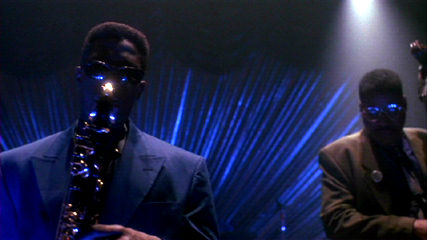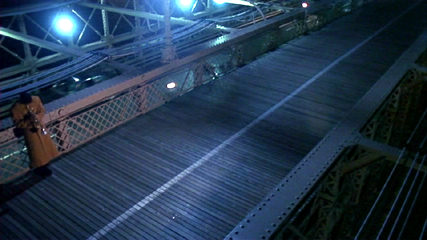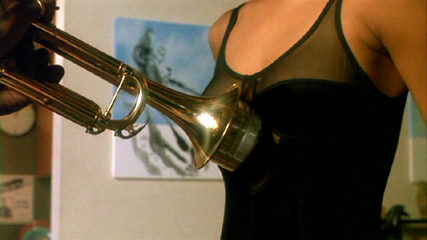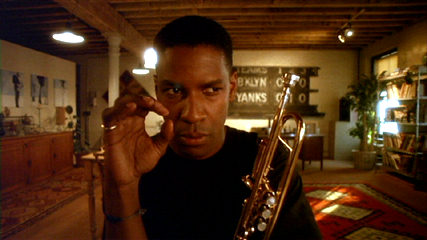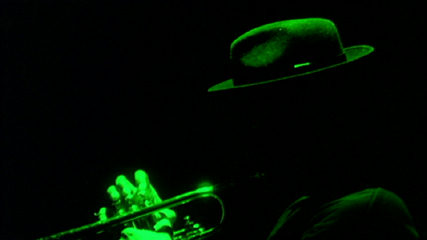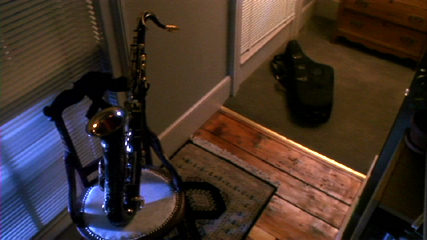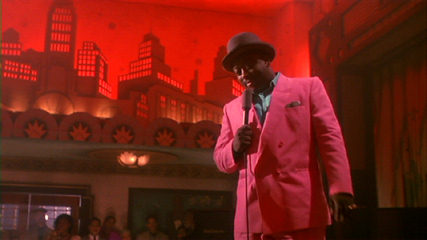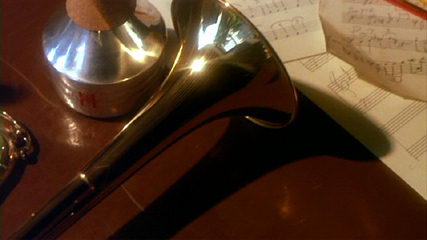|
"When all is said and done
... there's nothing else to do or say"
Darryl "Chocolate Thunder" Dawkins
Two thumbs way up.
Scoop's comments in white:
I guess it is fair to say that Spike Lee is not
just a black man who makes films, but is truly a "black filmmaker",
in that his films specifically treat certain aspects of the black
experience in America. The reason I make that distinction is that
Lee has obviously given a lot of thought, perhaps even obsessed
over, issues that the rest of us have never thought about, even if
we are white filmmakers or other black men who make films.
Imagine the possibilities, if you will, inherent
in a very dark-skinned man in a completely dark room wearing a white
suit and a white hat. Bathe him in colored track lighting, and you
can create the illusion of a green hat and suit walking around, like
the invisible man. Now imagine a dark-skinned black woman and a
light-skinned white woman standing side by side in a room. It is
nighttime, so there is no sunlight to consider. Bathe the room in
beautiful blue lights. The white woman still looks the same, except
maybe that she might have eaten some clams during the Red Tide. The
black woman's skin, however, now takes on a beautiful blue hue.
She's a blue woman. You probably never thought about those things,
and neither had I, but Spike has, and used them to create a dazzling
array of ultra-cool effects. Imagine Denzel Washington with a
polished trumpet and Wesley Snipes with a glistening sax. Add the
right kind of cool shades. Dress them in the right colors. Put them
in a dark, smoky nightclub with a dark backdrop. Put some shiny
surfaces and small lights behind them. Bathe the room in blue light.
It's magic. Now use some indirect lighting to light the backdrop in
blue as well. Now change the indirect lighting and color the
backdrop rose. And so forth.
What you have is a visual poem about the powers of
light and darkness and their ability to create and transform moods.
You have a jazz riff played out with lights and camera instead of a
trumpet and a saxophone.
This film is among the most artistic and
aesthetically brilliant I've ever seen. In addition, Lee and DP
Ernest Dickerson use the camera in the same way that Michelangelo
used a chisel to transform ugly chunks of rocks into beautiful hands
and feet. They transform ordinary interiors into magical venues; they change an
ordinary
trumpet into an objet d'art, then they complete the
metamorphosis by spinning the straw of mundane
New York exteriors into a golden treasury of memories and evocative
moments. Hey, I know that last simile was stretching it, but you
have to admit that Spike does look a lot like Rumpelstiltskin. Spike
and Dickerson always delight and amaze me with the way the use that
camera - with their creative choices for the initial set-up of the
camera angle in each scene, and then with the movement of the camera
through the scene.
And it's difficult to argue with the musical
choices. If you like the music of John Coltrane, Miles Davis and
Branford Marsalis, you are gonna go nuts over this biography of a
trumpeter who plays that kind of music with a quintet in uptown jazz
clubs.
If a movie consisted only of camera angles, camera
movement, lighting, photographic composition, storyboarding,
production
design, interior locations, exterior locations, music, mood and
atmosphere, this movie could be considered the Citizen Kane of the
90's. If you love New York City, progressive jazz/blues, and dazzling
photographic presentation, this is your film, hands down.
Of course, there is more to a movie than that.
There is a script. Storylines. Important themes. I'm not too sure
those things should be weighted too heavily when evaluating this
film, since it is akin to saying that the plot of Hamlet is kinda
stupid, which it is, but who cares? But the script is the film's Achilles Heel. The great weakness of the film is that
Lee's story is
completely conventional. I didn't see anything new here that I
haven't seen in earlier movies like Young Man With a Horn, except
that the experiences are specifically filtered through the urban
middle-class black experience.
In the opening scene, a young boy wants to play
baseball but his mom makes him play the trumpet. He tells mom that
he hates the trumpet. We see him next as an adult, and it is then
obvious that he loves the trumpet, and values his music above his
need for romantic love, over his need to fire his incompetent
manager (played by Lee himself), and over his relationships with the
members of his ensemble. We see that he's a good man. His
incompetent manager has been his best friend since third grade, and
he takes care of his friend. But as good as his intentions might be,
his obsession with music and his loyalty to his friend are gradually
isolating him from everyone else, and chopping off the legs of his existence.
|
